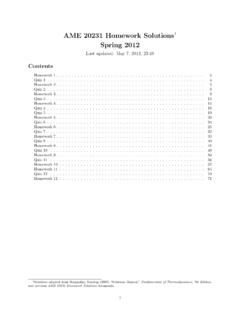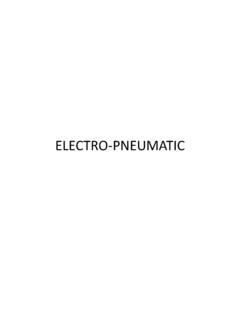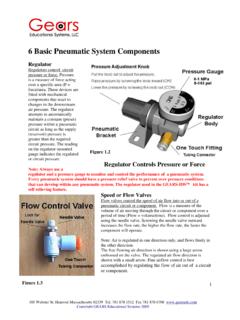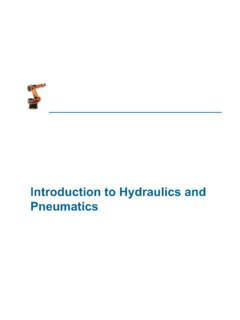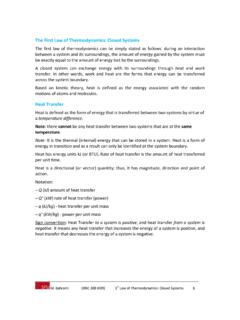Transcription of Engineering Fundamentals- Thermodynamics
1 Engineering Fundamentals- Thermodynamics By Professor Paul A. Erickson Basic Thermodynamics Conservation of Mass Conservation of Energy Principle of State and Phase Principle of Entropy Thermodynamic Cycles Carnot Rankine Air Standard Cycles Otto Diesel Brayton Refrigeration Cycle (also Heat Pump). Air/Water Mixtures Basic Thermo Processes and Terms Intensive and Extensive Properties Adiabatic Compressibility Isothermal Reduced Temperature and Isobaric Pressure Isometric or Isochoric Constant and Variable Specific Isentropic Heat Isenthalpic Relative Pressure and Volume Polytropic Flow Work Boundary Work Ideal Gas Enthalpy Incompressible Entropy substances Thermal Efficiency and COP. Relative and Absolute Humidity Conservation of Mass Epicurus (341 270 BC). Describing the nature of the universe, "the sum total of things was always such as it is now, and such it will ever remain.
2 ". Input = Storage - Output Must be linked with Conservation of Energy E mc 2. Continuity Equation Conservation of Mass (Total Mass Entering a System)-(Total Mass Leaving the System) =. Net change in mass within system mi mcv me Steady flow implies no change in mass within cv d m e - m i + dt mcv = 0. Conservation of Energy Lights on or off Energy is always conserved But that isn't what they mean! Energy is neither created nor destroyed 1st Law of Thermodynamics Conservation of Energy Energy can neither be created nor destroyed Input Output Storage W Q me out in . me d dt . me cv 0 . Where W is the work done by the system Q is V2. the heat transferred to the system and e h gz 2. Using Conservation of Energy What is the output shaft power? ENG 105 8. Using Conservation of Energy A refrigeration cycle has heat transfer Qout 3200 Btu and net work of Wcycle 1200 Btu.
3 Determine the coefficient of performance for the cycle. High Temperature Reservoir Qh W. Ql Qh = Ql + W. Low Temperature Reservoir ENG 105 9. Using Conservation of Energy A heat pump cycle whose coefficient of performance is delivers energy by heat transfer to a dwelling at a rate of 20 kW. (a) Determine the net power required to operate the heat pump, in kW. (b) Evaluating electricity at $ per determine the cost of electricity in a month when the heat pump operates for 200 hours. ENG 105 10. Using Conservation of Energy For a power cycle, the heat transfers are Qin 25,000 kJ and Qout 15,000. kJ. Determine the net work, in kJ, and the thermal efficiency. High Temperature Reservoir Qh W. Ql Qh-Ql=W. Low Temperature Reservoir ENG 105 11. Perpetual Motion W Q me out in . me d dt . me cv 0. Perpetual Motion is a Technical Foul Principle of State and Phase-Terms Intensive and extensive properties (State Postulate).
4 Pure substance Equilibrium Specific properties Compressed (Sub Cooled) Liquid Quality Two-phase region Can You find Properties??? Vapor dome Superheated region Critical properties Ideal gas Gas constant Compressibility factor Reduced temperature and pressure Compressed liquid assumption Thermodynamic Properties Volume Specific Volume Density Pressure Gauge Absolute Units Temperature Units and Scales Energy Internal Energy Enthalpy (internal energy + boundary/flow work). Kinetic and Potential Quality Entropy The state postulate The minimum number of independent intensive properties to find the state for a simple compressible system is two. Two-phase region Superheated vapor Triple line Saturation state Compressed liquid Vapor dome Critical point Fundamentals of Thermal Fluid Sciences 3rd Edition Yunus A. Cengel Robert H.
5 Turner John M. Cimbala 2008. Look up Properties for Each Case Pressure is 100kPa Review Quality Equations subscripts f,fg,g (a) is saturated liquid (a) is liquid at 20 C. (b) is two phase quality (x) of .7. (c) is saturated vapor (c) is superheated vapor at 120 C Introduction to Thermal Systems Engineering : Thermodynamics , Fluid Mechanics, and Heat Transfer Michael J. Moran Specific volume, specific internal energy, specific Howard N. Shapiro Bruce R. Munson enthalpy, and specific entropy as properties David P. DeWitt John Wiley & Sons, Inc. 2003. Saturated Water Pressure Table Introduction to Thermal Systems Engineering : Thermodynamics , Fluid Mechanics, and Heat Transfer Michael J. Moran Howard N. Shapiro Bruce R. Munson David P. DeWitt John Wiley & Sons, Inc. 2003. Saturated Water Temperature Table Introduction to Thermal Systems Engineering : Thermodynamics , Fluid Mechanics, and Heat Transfer Michael J.
6 Moran Howard N. Shapiro Bruce R. Munson David P. DeWitt John Wiley & Sons, Inc. 2003. Introduction to Thermal Systems Engineering : Thermodynamics , Fluid Mechanics, and Heat Transfer Michael J. Moran Howard N. Shapiro Bruce R. Munson David P. DeWitt John Wiley & Sons, Inc. 2003. THE IDEAL-GAS EQUATION OF STATE. Equation of state: Any equation that relates the pressure, temperature, and specific volume of a substance. The simplest and best-known equation of state for substances in the gas phase is the ideal-gas equation of state. This equation predicts the P-v-T. behavior of a gas quite accurately within some properly selected region. Ideal gas equation of state R: gas constant M: molar mass (kg/kmol). Ru: universal gas constant Different substances have different gas constants. Ideal Gas pV=mRT. pV=nRuT. Ideal gas model only valid away from two phase region and critical point Fundamentals of Thermal Fluid Sciences 3rd Edition Yunus A.
7 Cengel Robert H. Turner John M. Cimbala 2008. An automobile tire is inflated with air. The pressure rise of air in the tire when the tire is heated to 50 C and the amount of air that must be bled off to reduce the pressure to the original value are to be determined. Assumptions 1 At specified conditions, air behaves as an ideal gas. 2 The volume of the tire remains constant. Properties The gas constant of air is R = Analysis Initially, the absolute pressure in the tire is P1 Pg Patm 210 100 310kPa Initial Condition Tire Treating air as an ideal gas and assuming the volume of the tire 25 C. to remain constant, the final pressure in the tire can be 210. determined from kPa P1V1 P2V2 T 323 K.. P2 2 P1 (310 kPa) 336 kPa T1 T2 T1 298 K. Thus the pressure rise is P P2 P1 336 310 26 kPa The amount of air that needs to be bled off to restore pressure to its original value is P1V (310 kPa)( m3 ).
8 M1 kg RT1 ( kPa m3/kg K)(298 K). P1V (310 kPa)( m3 ). m2 kg RT2 ( kPa m3/kg K)(323 K). m m1 m2 kg Compressibility Factor Reduced Reduced pressure temperature Pseudo-reduced specific volume Gases deviate from the ideal-gas behavior the most in the neighborhood of the critical point. Comparison of Z factors for various gases. Charles' and Boyle's Law Uses ideal gas law and conservation of mass in steady flow to determine volume at another pressure and temperature. V2 P2 T1. V1 Derive T2 P1. Exhaust emissions at collected temperature and pressure to standard temperature and pressure Ambient Standard 1 bar 25 C. Standard 1 atm 0 C. Specific Heat Constant volume (Internal Energy). Constant pressure (Enthalpy). Ratio of specific heats Specific heat Solids Liquids Introduction to Thermal Systems Engineering : Thermodynamics , Fluid Mechanics, and Heat Transfer Michael J.
9 Moran Howard N. Shapiro Bruce R. Munson David P. DeWitt John Wiley & Sons, Inc. 2003. The compressed liquid properties depend on temperature much more Compressed strongly than they do on pressure. y v, u, or h Liquid A more accurate relation for h Assumption At a given P. and T, a pure A compressed liquid substance will may be approximated exist as a as a saturated liquid at compressed the given temperature. liquid if Principle of Entropy Total Entropy is ALWAYS increasing 2nd Law of Thermodynamics Irreversibilities Friction Unrestrained expansion Heat Transfer Mixing Resistance etc Carnot Efficiency and Coefficient of Performance Isentropic Efficiency What creates Entropy Major Irreversibilities Friction Unrestrained Expansion Heat Transfer Minor Mixing, spontaneous reaction Resistance Total entropy always increases Carnot Heat Engine Th Sh S gen Sl 0.
10 Qh Sh Sh Qh Th Ql Qh . Tl Th Sgen Cyclical Process W. Ql Ql Tl Sl 1 1 . Tl Sl Ql Qh Th Tl Tl max 1 . Th Any thermal efficiency above Carnot thermal efficiency is a violation of the Second Law Perpetual Motion Machine of the 2nd Kind PMM-2. This concept applies to heat engines, refrigerators, heat pumps and any other system The best you can do is to have no change in entropy on the WHOLE system. (individual processes may see reductions in entropy). Perpetual Motion is a Technical Foul Examples An inventor claims to have built a device which receives 1000 kJ at 500K and converts it to 410 kJ exhausting heat to the environment at 300K. Is this Possible? Max Efficiency = 1-Tl/Th =1- (300K/500K)=40%. Isentropic Efficiency Processes are not Isentropic Isentropic cases are a best case scenario Efficiency can be related to the Isentropic case Turbines Pumps and Compressors Nozzles Isentropic Efficiency Actual Turbine Work Wa h1 h2 a T.


